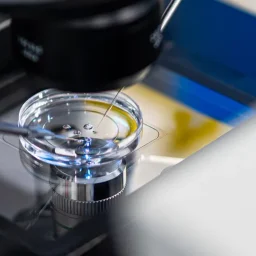
Advancements in Assisted Reproductive Technology (ART) have revolutionized reproductive medicine, offering new hope to couples facing difficulties conceiving. Behind every successful treatment lies a multidisciplinary team, yet one of the most crucial players is the embryologist. This professional is responsible for the handling, culture, and evaluation of gametes and embryos—tasks that demand extreme precision and a highly controlled working environment. However, the impact of this environment on the embryologist’s health is an aspect that warrants special attention.
The work of the embryologist in assisted reproduction: a delicate balance
The embryologist performs complex procedures such as in vitro fertilization (IVF), embryo biopsy, and embryo culture, which require concentration, technical skills, and meticulous attention to detail. Each step must be carried out under optimal conditions to maximize the chances of success, as any error can affect the embryo’s viability.
This level of precision demands long working hours and often rotating shifts to ensure constant monitoring of the embryos, which can lead to physical and mental fatigue. In addition, the embryologist handles chemical substances and biological materials, adding specific risks to their work environment.
Physical risks in the assisted reproduction laboratory
Exposure to chemical substances and biological agents:
Embryologists work with culture media, reagents, and other chemical products that, if not handled properly, can cause irritation or toxicity (Riestenberg et al., 2020). Moreover, contact with biological material entails potential infection risks, making strict adherence to biosafety regulations essential.
Musculoskeletal disorders:
The repetitive nature of the work and the need to maintain static postures for extended periods while operating microscopes and delicate equipment can lead to musculoskeletal disorders, such as pain in the back, neck, shoulders, and limbs (Smith & Jones, 2018). These conditions not only affect the embryologist’s well-being but may also impact their performance and concentration.
Visual fatigue:
Working for long hours with microscopes and screens can lead to eye strain, blurred vision, and headaches—factors that affect both productivity and the quality of work (WHO, 2019).
Emotional impact and occupational stress:
The embryologist faces not only physical challenges but also emotional ones. The responsibility of handling human reproductive cells and the expectations of patients create a high-pressure environment. Ongoing stress can lead to emotional exhaustion, anxiety, and, in some cases, depression (Briggs et al., 2017).
In addition, interaction with patients going through sensitive and uncertain situations adds an emotional component that must be properly managed to prevent professional burnout.
Measures to Safeguard Embryologist Health
Safety and Ongoing Training:
Continuous training in the safe handling of materials and adherence to established protocols is essential to reduce chemical and biological risks. Staying up to date with best practices and regulations ensures a safe working environment (Riestenberg et al., 2020).
Ergonomics and Workplace Design
Implementing ergonomic workstations with adjustable chairs and tools that promote comfortable posture helps prevent musculoskeletal disorders. Encouraging active breaks and stretching exercises throughout the workday is also fundamental to reducing physical fatigue (Smith & Jones, 2018).
Stress Management and Psychological Support:
Incorporating stress management programs—such as mindfulness, psychological therapy, and support groups—contributes to improving embryologists’ mental health. Creating a collaborative work environment with open communication allows for early intervention in emotional challenges (Briggs et al., 2017).
Regular Medical Monitoring:
Routine medical check-ups should include visual, musculoskeletal, and psychological assessments to detect and address any issues related to the professional’s occupational activity in a timely manner (WHO, 2019).
Benefits of Promoting Embryologist Health
Investing in the health and well-being of embryologists has a positive impact on multiple levels:
-
Improved quality of work and treatment outcomes.
-
Reduced absenteeism and staff turnover.
-
A healthier, more motivating work environment.
-
Increased safety for patients and team members.










